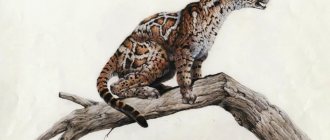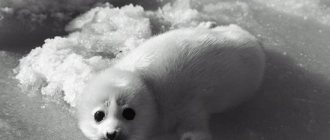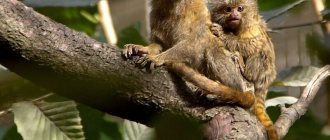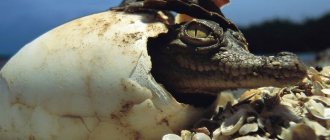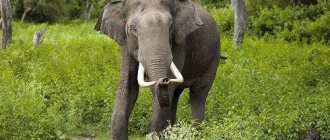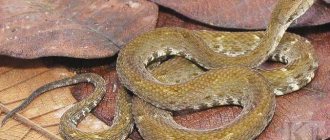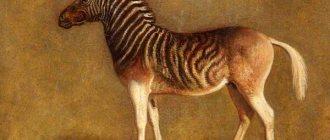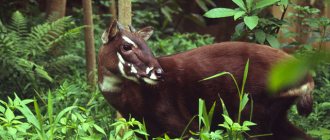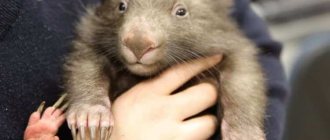Marsupial wolf
People are responsible for negative changes on Earth. Unfortunately, the extinction of entire animal species in many cases is also a consequence of human activity. The disappearance of animals is correlated with hunting, poaching, environmental pollution, destruction of natural habitats, climate change - everything for which humans are in one way or another responsible. It is said that we have entered the sixth mass extinction, and if the current pace does not stop, our planet will have to spend millions of years recovering lost biodiversity.
In this article we want to talk about 20 species of animals that have become extinct as a result of human activity.
Mauritian dodo
The Mauritian dodo, or dodo, lived only on the island of Mauritius. The appearance of the dodo is not known for certain, because its image was reconstructed only from images and written sources of the 17th century. The bird's remains show that the Mauritian dodo stood about 1 meter tall and could weigh up to 18 kilograms. With the appearance of humans on the island, the bird often became a victim of people and domestic animals. The last time a living dodo was seen was in 1662.
Mauritian dodo or dodo
Canary Black Oystercatcher
Declared extinct in 1994.
Photo: fishki.net
The Canary Black Oystercatcher lived in West Africa on the Atlantic coast. This bird also suffered at the hands of humans. It is worth noting that people did not hunt this bird, but still brought it to starvation.
Quagga
Quaggas, who lived in South Africa, were perhaps the only extinct animals whose representatives were domesticated by humans. They were used to protect herds: quaggas noticed the approach of predators before the cattle and warned the owners with a loud cry of “quaha”, from which they got their name. The Boers ethnic group killed these animals for their tough hides and tasty meat. The last quagga in the world died at the Amsterdam Zoo in 1883.
Quagga
Zanzibar leopard
The extermination of the Zanzibar leopard is both similar and different from the extermination of other species on our list. They killed the leopard, they killed it purposefully and very actively, they declared a hunt for the animals and the whole village went after them. However, this was not done for the sake of its meat or skin, and not in order to protect the village and livestock from potential attacks by the animal. The fact is that the population of the Zanzibar archipelago was firmly convinced that these leopards were associated with witches, that evil witches specially bred and trained these animals to help them, and then sent the leopards to do dirty deeds for them. The extermination campaign began in the second half of the 1960s, and after just 30 years there were almost no Zanzibar leopards left in the wild. Scientists began to sound the alarm in the early 90s of the last century, but a few years later the program to preserve the species was curtailed as unpromising. Year of complete disappearance: 1990s
Steller's cow
Steller's cow, or sea cow, lived only off the coast of the Commander Islands. It was a very large animal, reaching a length of 8 meters and five tons of weight. She was distinguished by her slowness, apathy and lack of fear of humans. Extermination for the sake of tasty meat of the sea cow led to the complete disappearance of this animal by 1768 - just 27 years after its discovery.
Steller's cow
Interesting tests
Logic and logical thinking test
You'll have to strain your brain.
Test for knowledge of phraseological units
Evaluate the richness of your speech by taking a test on your knowledge of phraseological units.
Animal knowledge test
Guess what animal is in the photo?
English Vocabulary Test
Check your knowledge of English words.
Tour
Aurochs were wild bulls, the ancestors of modern cattle. In historical times, these animals were found throughout Europe, as well as in North Africa, Asia Minor, India and the Caucasus. The last individual died in 1627 from illness. If it were not for intensive hunting and human economic activity, the aurochs might have survived to this day.
Tour
Gray Kangaroo
Considered extinct since 1937.
Illustration: ru.wikipedia.org
Gray's kangaroos lived in the south and southeast of Australia. Individuals of this species could be found in open spaces next to eucalyptus forests, in which these animals hid during the rains.
The animal was named in honor of Sir George Gray, who served as Governor of South Australia from 1812 to 1898.
Like other members of the kangaroo family, Gray's kangaroos ate plant foods, mainly the foliage of bushes and trees.
The main cause of extinction is considered to be poaching - people hunted kangaroos for their fur and meat. In addition, scientists believe that the reason for the decline in the population of Gray's wild kangaroos is attacks on us by predatory animals.
Gray's last wild kangaroo was killed in 1924, and the last individual living in the national park died in 1937.
Great auk
A large flightless bird, the great auk, which lived in the cold coastal waters of the North Atlantic, reached 85 centimeters in length and weighed about 5 kilograms. Due to human hunting of the bird for its meat, fluff, and use as bait, its numbers were greatly reduced by the 16th century. The great auk was last seen in the mid-1800s. She became the first of the European and American birds to be completely destroyed by humans.
Great auk
Woolly Mammoth
It is believed that this type of mammoth first appeared in Siberia about 300-250 thousand years ago and gradually spread to Europe and North America. The dimensions of mammoths were not as huge as most people not very familiar with history believe: they were only slightly larger than modern elephants. Mammoths lived in groups, led by the eldest female, and constantly moved from place to place, since an adult mammoth required about 180 kilograms of food daily. Which - and this is obvious - does not imply marking time in one place. The completely woolly mammoth disappeared about 10 thousand years ago. And although there are many theories about why they became extinct (loss of genetic diversity, climate change, epidemic outbreak, etc.), modern research is increasingly inclined to believe that it was the hand of man that dealt the final blow to this type of mammoth. Time of complete extinction: 10,000 years ago
Marsupial wolf
In historical times, the marsupial wolf (also Tasmanian wolf or thylacine) lived only on the island of Tasmania. Until the beginning of the 19th century, this animal was distributed throughout the island, until the mass extermination of this animal, which was considered an enemy of domestic sheep, began in the 30s of the same century. The authorities gave bonuses to hunters for the head of each killed animal. The last marsupial wolf died of old age in a private zoo in 1936.
Marsupial wolf
Island hutia
Considered extinct since 1950.
Photo: Harvard Museum of Natural History/Peabody Museum
The island hutia lived exclusively on the island of Little Cisne in the Caribbean Sea (territory of Gohonduras). Due to the fact that the base of the island on which the Huti lived consists mainly of coral rock, these animals, as a rule, could not dig holes, so they settled in the crevices of the coral rock.
Representatives of the species were herbivores. Their weight could reach one kilogram, and the body length of an adult was 33-35 centimeters. The sizes of males practically did not differ from the sizes of females.
It is believed that the island's Hutias were exterminated by cats brought to the island by people. The last mention of these creatures dates back to 1950.
Variegated Huia
The variegated huia lived only on the North Island of New Zealand. A notable feature of Huia was the presence of a very pronounced anatomical difference between the female and the male. The female's beak was long, thin and curved downwards, while the male's was short and thick, like a raven's. The main reasons for the extinction of these birds were uncontrolled hunting for tail feathers, as well as deforestation of lowland forests where huias lived. This bird was last seen in the early 20th century.
Variegated Huia
Japanese sea lion
Considered extinct since 1974.
Photo: ru.wikipedia.org
The Japanese sea lion lived in the Sea of Japan on the west and east coasts of Japan, as well as on the east coast of Korea.
In addition, it could be found on the Ryukyu Island (Japan), on the southern coast of the Russian Far East, on the Kuril Islands, Sakhalin and in the south of the Kamchatka Peninsula in the Sea of Okhotsk.
The main reason for the extinction of the Japanese sea lion is considered to be hunting and persecution by fishermen.
Scientists estimate that in the 19th century the population of Japanese sea lions numbered from 30 to 50 thousand individuals. Uncontrolled hunting of them and development of their habitats has led to a terrifying reduction in their numbers. The last reliable information about 50-60 individuals was obtained in 1951, when a small population was discovered on the Liancourt Islands.
The last time a Japanese sea lion was seen was in 1974 on the coast of the small island of Rebun. Since that time, no one has seen these animals again.
Chinese river dolphin
The Chinese river dolphin lived in the Chinese Yangtze River and in lakes Dongting and Poyang. They stayed at the mouths of tributaries and in shallow, muddy water where vision was practically useless. Therefore, these dolphins had very poor vision and relied on echolocation. In 2022, China's Endangered Animal Commission declared the species extinct.
Chinese river dolphin
Other animals of the Black Book
moa bird
A huge bird, up to 3.5 meters high, that lived in New Zealand. Moa is a whole order, within which there were 9 species. All of them were herbivores and ate leaves, fruits, and shoots of young trees. Officially extinct in the 1500s, there is anecdotal evidence of moa sightings in the early 19th century.
Great auk
A flightless bird, the last sighting of which was recorded in the mid-19th century. Typical habitat is hard-to-reach rocks on islands. The great auk's main diet is fish. Completely destroyed by humans due to its outstanding taste.
Passenger pigeon
A representative of the pigeon family, distinguished by its ability to migrate over long distances. The passenger pigeon is a social bird that lives in flocks. The number of individuals in one flock was huge. In general, the total number of these pigeons in the best of times allowed them to be given the status of the most common bird on Earth.
Caribbean seal
A seal with a body length of up to 2.5 meters. Color – brownish with a gray tint. Typical habitat is the sandy shores of the Caribbean Sea, the Gulf of Mexico, and the Bahamas. The main part of the diet was fish.
Worcester three-finger
A small bird similar to a quail. It was quite widespread in Asian countries. Typical habitat is open spaces with dense bushes or forest edges. She had a very secretive and solitary lifestyle.
Marsupial wolf
A mammal that lived in Australia. It was considered the largest of the marsupial predators. Due to a whole range of reasons, the marsupial wolf population has decreased so much that there is reason to assume complete extinction. However, there are modern unconfirmed facts of encounters with individual individuals.
Cameroon black rhinoceros
It is a large, strong animal with a body weight of up to 2.5 tons. Typical habitat is African savannas. The black rhino population is in decline, with one subspecies officially declared extinct in 2013.
Rodriguez parrot
A bright bird from the Mascarene Islands. There is very little information about him. All that is known is the red-green coloration of the feathers and the massive beak. Theoretically, it had a subspecies that lived on the island of Mauritius. At the moment there is not a single representative of these parrots.
Mika the crested pigeon
Officially declared extinct in the early 20th century. Birds of this species lived in New Guinea, providing a source of food for the local population. It is believed that the artificial settlement of territories by cats led to the extinction of the crested pigeon.
Heather grouse
A chicken-sized bird that lived on the New England plains until the 1930s. As a result of a whole range of reasons, the bird population has decreased to a critical level. A reserve was created to save the species, but forest fires and severe frosty winters led to the death of all heather grouse.
Falkland fox
A little-studied fox that lived exclusively on the Falkland Islands. The fox's main food was birds, their eggs and carrion. During the development of the islands by people, foxes were shot, as a result of which the species was completely destroyed.
Taiwan clouded leopard
This is a small predator, weighing up to 20 kilograms, which spent most of its life in trees. The last representative of the species was seen in 1983. The cause of extinction was the development of industry and deforestation. Some scientists believe that several individuals of this leopard may have survived in certain areas of its habitat.
Chinese paddlefish
The largest freshwater fish, up to three meters long and weighing up to 300 kilograms. Anecdotal evidence suggests individuals are seven meters long. The paddlefish lived in the Yangtze River, periodically swimming into the Yellow Sea. At the moment, no living representative of this species is known.
Mexican grizzly
It is a subspecies of brown bear and lived in the United States. The Mexican grizzly bear is a very large bear with a distinctive “hump” between the shoulder blades. Its color is interesting - generally brown, it could vary from light golden to dark yellow shades. The last specimens were seen in the state of Chihuahua in 1960.
Paleopropithecus
It is a genus of lemurs that lived in Madagascar. This is a large primate, with a body weight of up to 60 kilograms. The lifestyle of Paleopropithecus is predominantly arboreal. There is an assumption that he almost never came down to earth.
Iberian ibex
It lives in Spain and Portugal. Previously, it was widespread throughout the Iberian Peninsula, however, as a result of hunting, the number of the species has decreased to a critical level. Now found at altitudes up to 3,500 meters above sea level.
Chinese river dolphin
The species was discovered relatively recently - in 1918. Typical habitat is the Chinese Yangtze and Qiantang rivers. It has poor eyesight and a developed echolocation apparatus. The dolphin is declared extinct in 2022. Attempts to locate surviving individuals were unsuccessful.
Epiornis
A flightless bird that lived in Madagascar until the mid-17th century. Currently, scientists periodically discover eggs of these birds that have survived to this day. Based on the analysis of DNA obtained from the shell, it can be said that Epiornis is the ancestor of the modern kiwi bird, which, however, is much smaller in size.
Bali tiger
This tiger was very modest in size. The length of the fur was much shorter than that of other tigers. The coat color is classic, bright orange with transverse black stripes. The last Bali tiger was shot in 1937.
Bare-chested kangaroo
This animal looks more like a rat, to which family it belongs. The naked-breasted kangaroo lived in Australia. It was a small animal, with a body weight of only one kilogram. It was most common on plains and sandy ridges with the obligatory presence of dense bushes.
Barbary lion
This subspecies of lions was quite widespread in North Africa. He was distinguished by a thick dark mane and a very strong physique. It was one of the largest lions in modern animal history.
Turanian tiger
The Turanian tiger, also the Transcaucasian tiger or Caspian tiger, lived in Central Asia, northern Iran and the Caucasus. This subspecies was distinguished by its bright red coat color, as well as the length of its stripes - they were longer and had a brownish tint. The last time the Transcaucasian tiger was seen was in 1957, and was declared extinct only 13 years later, in 1970.
Turanian tiger
Pygmy Grebe
It was declared extinct in 2010.
Photo: fishki.net
The habitat of the pygmy grebe was very narrow; this bird could only be found on Lake Alautra on the island of Madagascar (Toamasina province).
The cause of the extinction of pygmy grebes is considered to be human activity in the habitat of this bird. Pygmy grebes often died getting entangled in fishing nets, and they periodically became targets for poachers.
Scientists also believe that a significant blow to the population of these birds was dealt after people began to introduce new species of fish to Lake Alautra. The thing is that the pygmy grebe ate lake fish and after new species of fish began to reproduce, the number of fish familiar to its diet began to decrease and the birds began to die of hunger.
It is worth noting that the pygmy grebe has been endangered since the early eighties. The last time the voice of this bird was seen was in 1988, and in 2010 the pygmy grebe was officially declared extinct.
Syrian kulan
It is believed that the Syrian kulan is the same “wild ass” with which the angel compared Ishmael when he prophesied a great future for him in the Book of Genesis in the Old Testament. Previously, this animal was found in the territory of modern Syria, Israel, Jordan, Saudi Arabia and Iraq. The extinction of the species is associated with overfishing. The last representative of the Syrian kulan died in 1927 in the Vienna Zoo.
Syrian kulan
Abingdon elephant tortoise
The subspecies was declared extinct in 2012.
Photo: dailapky.ru
Representatives of this subspecies lived exclusively on Abingdon Island in the Pacific Ocean.
The Abingdon elephant tortoise is a species of Galapagos tortoise that was widespread in the area, but its numbers began to decline sharply after being hunted by sailors.
The only living representative of the Abingdon elephant tortoise subspecies was found in 1972 by the Hungarian scientist József Vágvöldi on Abingdon Island. Scientists gave the turtle the nickname Lonesome George - in honor of the American actor George Goebel.
George was kept in a pen on St. Croix at the Darwin Research Station. For decades, zoologists tried to get offspring from George, but nothing worked.
On June 24, 2012, the last of the Abingdon elephant tortoises died. At the time of his death he was about 100 years old. The body of the turtle was discovered without signs of life by the reserve's caretaker, Fausto Liereno, who had cared for Lonesome George for 40 years.
Falkland fox
The warrah or Falkland fox, which lived on the Falkland Islands, was the only land-based predator on these islands. Already in the early 1800s, the numbers of these animals were steadily declining due to uncontrolled shooting by hunters. In addition, the thick and fluffy fur of the Falkland fox was in great demand. The last Falkland fox was killed in 1876.
Falkland fox
Barbary lion
Considered extinct since 1922.
Illustration: ru.wikipedia.org
The Barbary lion lived in North African semi-deserts, steppes and forests, and was also common in the Atlas Mountains in northwest Africa.
The main distinguishing features of the predator are its very thick mane and large size. Male Barbary lions weighed from 160 to 250 kilograms, females weighed an order of magnitude less - from 100 to 170 kg. The mane of the Barbary lion grew not only on the neck and head, it went far beyond the shoulders and also grew on the stomach.
In ancient Rome, entertaining competitions involving the Barbary lion were common; his opponent was usually the Turanian tiger, which also became extinct.
The reason for the extinction of the subspecies is considered to be targeted extermination due to frequent attacks by Barbary lions on livestock; the number of predators decreased especially strongly after they began to use firearms for shooting.
The last Barbary lion was killed in 1922 in the Atlas Mountains in Morocco.
Schomburgk's deer
Schomburgk's deer lived in the swampy plains of central Thailand. Commercial rice production for export in Thailand has converted almost all of the grassland and marshy areas once inhabited by Schomburgk's deer into rice plantations. And intensive hunting for meat and horns, used in traditional Chinese medicine, continued to reduce the species' numbers until it became completely extinct. The last captive deer of this species was killed in 1938.
Schomburgk's deer
Tags: extinct animals, animals, history, people
Rate this article:
(votes: 48 , rating: 4.85 out of 5)
Caribbean monk seal
Despite the fact that living Caribbean monk seals were last seen in 1952, these animals were finally declared extinct only in 2008. Europeans in the 18th and 19th centuries actively hunted monk seals for their oil, which was used as lamp oil and lubricant for equipment. Along with the monk seals, its nose mites, insects that were only able to live in the noses of these animals, became extinct.
Year of complete disappearance: 2008
Introduction
The idea of creating a Red Book of Animals and Plants appeared in the middle of the last century. And already in 1966, the first copy of the publication was published, which included a description of more than a hundred species of mammals, 200 species of birds, and more than 25 thousand plants. In this way, scientists tried to attract public attention to the problem of the disappearance of some representatives of the flora and fauna of our planet. However, such a move did not particularly help in resolving this issue. Thus, every year the Red Book is steadily replenished with new species names. Few people know that there are also black pages of the Red Book. The animals and plants listed on them are irrevocably extinct. Unfortunately, in the overwhelming majority of cases this happened as a result of man's unreasonable and barbaric attitude towards the nature of our planet. The Red and Black Book of Animals today serve not so much as a signal, but as a cry for help to all people of the Earth due to the need to stop using natural resources exclusively for their own purposes. In addition, they convey information about the importance of a more attentive attitude to the beautiful world around us, inhabited by a huge number of amazing and unique creatures. The Black Book of Animals today covers the period from 1500 to the present day. Flipping through the pages of this publication, we can discover with horror that during this time about a thousand species of animals, not to mention plants, have completely died out. Unfortunately, most of them became direct or indirect human victims.
Burmese snub-nosed monkey
Previously, this species of monkey did not have law enforcement status, since it was discovered quite recently - in 2010. The monkey got its name because of the unusual structure of its nose, the nostrils of which are turned upward. Sometimes the animal is called a sneezing monkey: when it rains, water gets into the nostrils, and the monkey constantly sneezes. In 2012, the Burmese snub-nosed monkey was included in the list of endangered mammals in the Red Book. The updated version of the publication immediately classified it as a species with the greatest threat of extinction, because the number of monkeys is only about 300 individuals. This small population is at risk of extinction - humans are actively destroying their habitat. Hunters also contribute - monkey meat is quite tasty, and macaques can also be sold for the needs of Chinese medicine. The following fact is encouraging: in those rare moments when scientists were able to see snub-nosed monkeys, their numerous cubs were with the latter. Thus, there is a possibility of population reproduction.
Tesor doll
The Tecopa pupa (Cyprinodon nevadensis calidae) was native to the Mojave Desert in California and could survive in such warm waters, with temperatures exceeding 42⁰C. Human development around Tecopa Hot Springs in the mid-20th century and the confluence of the two springs has left the habitat unsuitable for small fish. The Tecopa pupa became extinct by 1970 or shortly thereafter.
Species extinct in the 16th century
Little is known about them. Thus, the rodents Noronhomys vespuccii are mentioned in records from 1503. This species is interesting because it lived on the islands of the Fernando de Noronha archipelago. It was here that the ships of the Florentine wanderer Amerigo Vespucci arrived at the beginning of the 16th century. Zoologists suggest that the local rodents were exterminated by ship rats that came to the islands from Vespucci's ships.
For the same reason - displacement from their native habitat - many animals became extinct at that time. But scientists have little information about the extinction of species before the beginning of the 17th century. And already since 1600 there are many interesting, documented facts.
rodents
Iberian ibex
The Iberian ibex (Capra pyrenaica pyrenaica) was a subspecies of the Iberian wild goat that became extinct in 2000. Once found in the French, Spanish and Andoran Pyrenees, the population was severely depleted by hunting. In 2009, scientists were able to clone a female Iberian goat using DNA from preserved skin samples. According to further data, due to lung defects, the capricorn died shortly after birth.
Steller's cormorant
Bird from the Commander Islands. They first learned about it during the sea expedition of Vitus Bering in 1741, but the bird received its name in honor of the naturalist Georg Steller. It was he who presented the first meaningful scientific description of the animal.
These were large birds (up to 6 kg, height - up to 1 meter) with black feathers and beautiful colors. Naturalists noted the characteristic purple, emerald, greenish-blue shades. It is not known for certain about the ability of cormorants to fly. Presumably, the birds did not fly due to their large size and spent a lot of time on the water, where they caught fish and sheltered from predators from land.
The fate of the birds was determined by their limited habitat. The first inhabitants of the Commander Islands appreciated the meat of cormorants. Since then, birds have been hunted. They weren't hard to catch. Large birds of the pelican order were sent for sale in hundreds. The Steller's cormorant is considered extinct in 1852.
Steller's cormorant
Rescue measures
In some countries, a species is considered extirpated, while in others there are still dozens or even hundreds of individuals. This is the situation with common brown bears in France. Animals are first raised in zoos. Then they are transferred to nature reserves. When there are enough of them, they are moved to their natural habitat. The main thing is not to delay salvation. There are now two turtles of the species Rafetus vietnamensis left in the world. But, judging by the fact that the female lays unfertilized eggs, her gentleman can no longer leave offspring.
Caucasian bison
The animal differed from its European relative in several external characteristics: the shape of the horns, coat color and size - the Caucasian bison were slightly smaller than the European ones. The first mention of the species dates back to the beginning of the 17th century.
Bison lived on a fairly large territory from the Ciscaucasia to Northern Iran. As always, poaching and reduction of pastures have caused the tragedy of this subspecies.
However, there were chances to save the Caucasian bison. At the beginning of the 20th century, scientists of the Russian Academy of Sciences brought up for discussion the issue of creating a protected area for the conservation of the subspecies. Then it was not possible to achieve the agreement of all participants in the negotiations, but the initiators continued to insist on their position. They achieved the creation of the reserve by 1924. Unfortunately, at that time there were about a dozen representatives of the subspecies left in nature. And even they could not be saved - poachers destroyed the last Caucasian bison in 1926.
Caucasian bison
